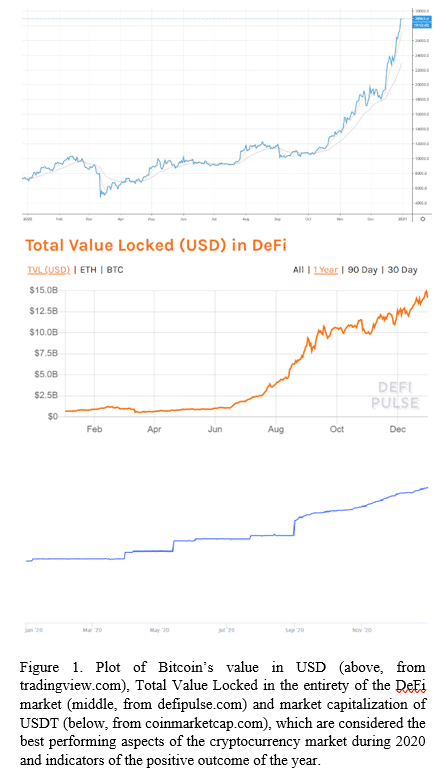2020 in Crypto – A review of the most important events in the market and trends to follow for 2021

With 2020 coming to an end, Gabriel Zanko takes the time to look back on the most relevant occurrences that shook the world of cryptocurrency and how the effects of these events have paved the road that the market will follow in the upcoming months
In this article we’ll be taking a look at analysis performed by the team at Messari to help us look at the bigger picture and set the foundations for the long term of digital assets.
INTRODUCTION
We are already on the homestretch of the year, and it cannot end soon enough for most people. Probably the most eventful year in recent history, 2020 was marked drastically by the pandemic of COVID-19 and worldwide lockdowns in attempts of controlling it, along with other multiple events that kept humanity on edge on what was coming next.
As expected, cryptocurrency was not exempt from this trend. Every month that passed felt like a big new announcement or movement was made, and this led to a new long-term bullish trend, which already showed its first results and has investors and enthusiasts on edge about what 2021 might bring. This is the reason why we are releasing this article, to summarize the biggest events in the crypto market during the year and to look forward to what 2021 promises at the moment.
Along the article we will be linking a number of research document we released during the year, in which we reviewed each important event in detail at the time of writing. Each of these documents could give you more insight in the important occurrences of 2020 and help in understanding the potential trends for the upcoming year. Let’s begin.
EVENTS OF 2020
The first noticeable effect of lockdowns and quarantine measures was the near elimination of the consumption side of the economy, which in turn left the productive side grasping for whatever help it could get. Those who were unlucky and could not translate their jobs at the time to a work-from-home alternative where faced with terrible decisions, from accepting pay cuts to simply losing their positions, which then started affecting their savings. This is where cryptocurrency shone for the majority of the year, as its role of an alternative to the traditional banking system and a way for people to protect their savings against situations that targeted the rest of the economy directly, and even more when this particular event was foreseen to last for many months after the initial lockdowns.
In more specific terms, one of the first big movements within the crypto market was the third
“Bitcoin Halving” during 2020, an automatic event that triggers once the Bitcoin chain reaches a certain length and that cuts the mining rewards for each block in the chain in half, which set it to its current 6.25 BTC per block. This was implemented all the way from its conception as a way to extend the lifespan of the currency, since there will be only 21 million BTC minted, and to combat inflation, but it also has effects on the mining environment. Previous halvings raised the question about how miners would face the change and reduction in profits, but also served as proof that these events usually mark the start of long-term bullish runs that raised the value of BTC, so that the halved rewards equaled to even greater profits than before the halving.
We also experienced the steep rise of the Decentralized Finance sector (parts I and II), which is both related to the rise of blockchain-based financial services due to the pandemic and to Compound (one of the largest and best ranked DeFi platforms) launching their COMP token, which meant they were launching their platform to complete public governance. With the feeling that the economy might be affected for many months, the derivatives market and asset digitization sector gained traction, and sooner than expected the DeFi sector went from $1 billion in Total Value Locked to nearly $4 billion in two months (from late May to late
July), then breaking the $10 billion line in September and its closing the year nearly at $15 billion.
Other analysts focus on the great advancements in terms of regulations. Back in July 2020, the OCC released a letter that allowed banks in the U.S. to hold crypto assets on behalf of their clients, meaning that the concept of cryptocurrency is being understood and accepted by the higher spheres in the economy, which then led to big leaps taken in the research and development of Central Bank-issued Digital Currencies, or CBDCs. The concept had been around for a while, but the looming shadow of a globalized economy entirely handled through the internet (boosted by the economic effects of the pandemic) threatened to take away the sovereignty of countries over their own economies, which is why CBDCs as a concept were so thoroughly studied during the year, with examples like Sweden’s e-krona and Uruguay’s ePeso, which are expected to help in the inclusion of the most marginalized parts of the population in regards of access to banking while giving support for almost unrestricted cross-border transactions.
Another big point for cryptocurrency was the public interest of multiple institutions and big brands in the field, with payments giant PayPal announcing in October they would start allowing users to buy, sell and hold cryptocurrencies through their system from 2021, which brought a wave of positive sentiment to the market. This, along with other highly anticipated announcements like Ethereum’s updated mainnet, Ethereum 2.0, already on the move, opened the doors for the entire market to reach new all-time highs, with the overall market capitalization breaching the $700 million mark and the giant of the market, Bitcoin, reaching a new roof by breaking the $25,000 line, and other big tokens are also well on their way to rise to historic levels.
ATTENTES POUR 2021
All of these events set the stage for what seems to be a very prolific 2021. With BTC on the rise, the rest of the market following its movements, institutional clients showing increasing interest and the seemingly friendly regulatory landscape, the next year could bring great advancements in many different fronts, as explained by Messari in their report for 2021.
- Public interest in crypto
The first great effect that we may see is even more interest from institutions and big client into crypto, specifically into Bitcoin since it is the most well-known token among the ocean of alternatives, which could turn the current bullish run into “the big one” that could take the crypto giant to the $100,000 level by the end of 2021. Furthermore, the dominance of the big names among their peers keeps increasing, with Bitcoin reaching nearly 90% dominance over other Proof-of- Work tokens, Ethereum closing in on 70% over other platform tokens and Tether representing 75% of the dollar-pegged stablecoins market, which makes them the potential first targets for enthusiasts and investors.
Fueled by the election of Joe Biden as President of the United States and the current toss-up in Georgia that will decide the majority of the Senate, the implementation of a new fiscal stimulus package will play an important part in the rest of the economy for the upcoming months, as they need to plan a way to combat the debt acquired in 2020, which could drive even more people towards cryptocurrency. According to the team at Messari, should the Congress remain split, money will continue to be printed in order to cover debts, which may destabilize the economy even more and thus drive more users towards cryptocurrency.
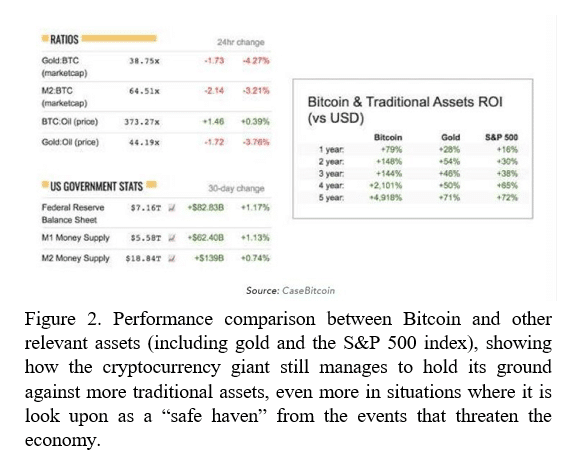
Another important aspect to consider is how Bitcoin has gradually drifted apart from its original intent, to the point where many experts agree that it is no longer private, which creates risks regarding scalability and fungibility. Many alternatives have popped up to complement BTC in this regard, but Messari believe that Zcash could be the best “hypermodel” among the crowd, as their key innovation was the introduction of “zero-knowledge proof” cryptography into its native payments network, which provides stronger privacy guarantees than typical blockchain transactions. Not only does Zcash offer a tangible solution to the issue, but it also shows how the crypto community is always eager to propose and test alternatives that could eventually lead to a nearly perfect environment.
- Ethereum and DeFi
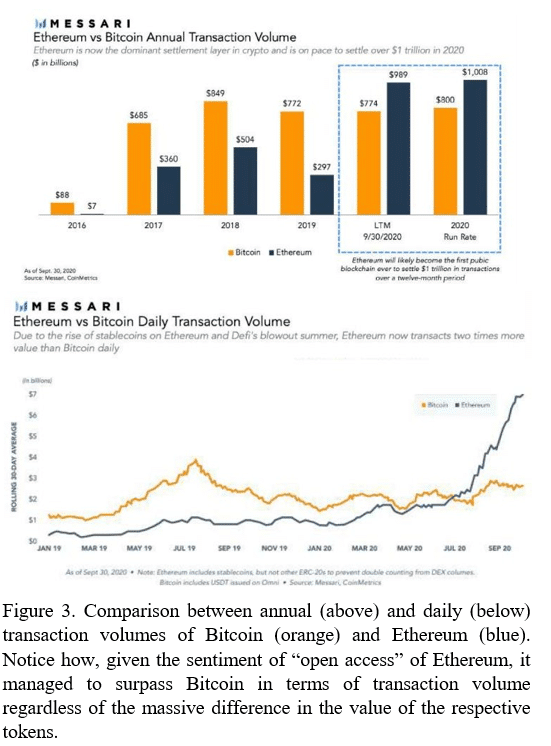
Ethereum is on pace to process more than $1 trillion worth of transactions this year, including the vast majority of volume in the burgeoning (and increasingly complex) DeFi and “crypto dollar” sectors. These two might even eclipse Bitcoin in importance, since they are focusing their growth on smaller users and enthusiasts looking for a way in, so 2021 could be an even greater year for these sectors as they cement their functions, great names and userbases. Ethereum could even take over the market momentarily in the – now, highly unlikely – case that Bitcoin fails due inflation destroying its security model, sovereigns choking liquidity providers or a massive hijack in mining capacity, but ETH would still not have the resilience to keep the market afloat. It will, however, remain valuable due to its status as a commodity (necessary for transaction usage), a capital asset (for network staking), and a form of money (reserve).
- Stablecoins
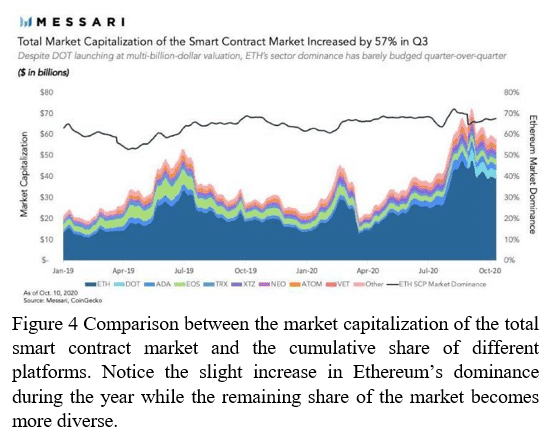
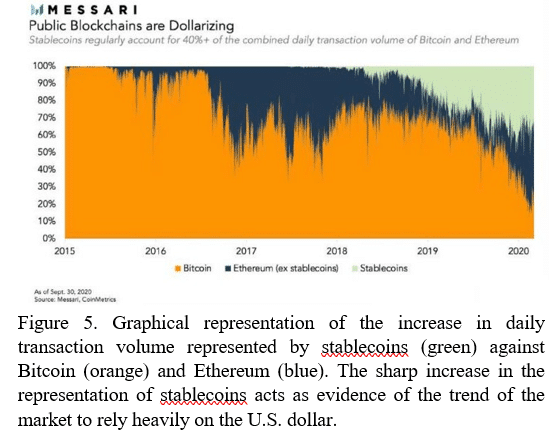
It is expected that crypto dollars on crypto platforms, synthetic assets, and Central Bank Digital Currencies (CBDCs) on state platforms will overtake platform tokens in circulating float in 2-3 years, and this expectation is supported by the reduction in risks on investment that the major tokens experienced during the year (BTC acting as digital gold and ETH as fuel for computing platforms), which translates directly to the safety of stablecoins.
III.e. Technical aspects

It is also important to look at how the diversification of consensus algorithms and encryption mechanisms alters the way mining works, and its possible impact in how the energy is used. Should the current trends continue, we may be looking at a situation where the theorized “duck curve” (Figure 7) becomes a reality, and me may even reach a point where proof-of-work mining could potentially reduce carbon emissions. Excess energy needs to get funneled off of overloaded power grids to some external source. What if Bitcoin mines could eventually serve as clean energy grid load balancers?
Last, but definitely not least, there are many analyses to perform regarding the situation of demand and supply of cryptocurrency, most relevantly Bitcoin, especially with the current panorama of increased performance. Regarding the use of cryptocurrency for custody, the team at Messari says that “much of the bitcoin that’s getting sucked up right now may never touch the market again. These are long-term positions getting built and plowed into cold storage for long-term use by investors and corporates with investment horizons of 5 to 10 years. And the ratio keeps getting further out of balance. New bitcoin purchases from PayPal, Square, and Grayscale already exceed newly mined BTC rewards, which means all of the bitcoin is essentially spoken for.” A similar phenomenon may be seen for demand and supply for countries, as more people keep struggling with their personal finances and high inflation, an increasing number of smaller fiat currencies may lose their balance in the upcoming years, which means that BTC could become their lifeline out of desperation, but is the big name of crypto ready for such demand?
CONCLUSION
Overall, 2021 presents us with opportunities to take the lessons learned in 2020 and continue to learn, this time with a hopefully less hostile environment, and to see how the advancements in cryptocurrency as a whole can coexist with economies focusing on combating debt and their eventual state of recovery. Unlike almost every other economic aspect, cryptocurrency was given great opportunities during 2020, and most of them resulted in setting the bases for healthy growth in the face of such situations, but 2021 will test the resilience of these foundations when the landscape is changed, and the signs point towards a positive outcome for users of all tiers and interests.
Article by Gabriel Zanko, Tech Advisor, CEO of MobileyourLife ( Investment Banking for Deep Technology and Renewable Energy), CEO of Urano Capital( the future Seed Fund for Deep Technology), researcher and speaker
Daniel Ramos, Gabriel Zanko, Mobileyourlife – Bogotá, D.C., Colombia
About AIBC:
AIBC Summit is a global expo covering topics relating to the global sectors for blockchain, AI, Big Data, IoT, and Quantum technologies. The event includes conferences hosted by globally renowned speakers, workshops for industry learning and discussion, an exhibition space accommodating more than 400 brands and a number of networking events.
